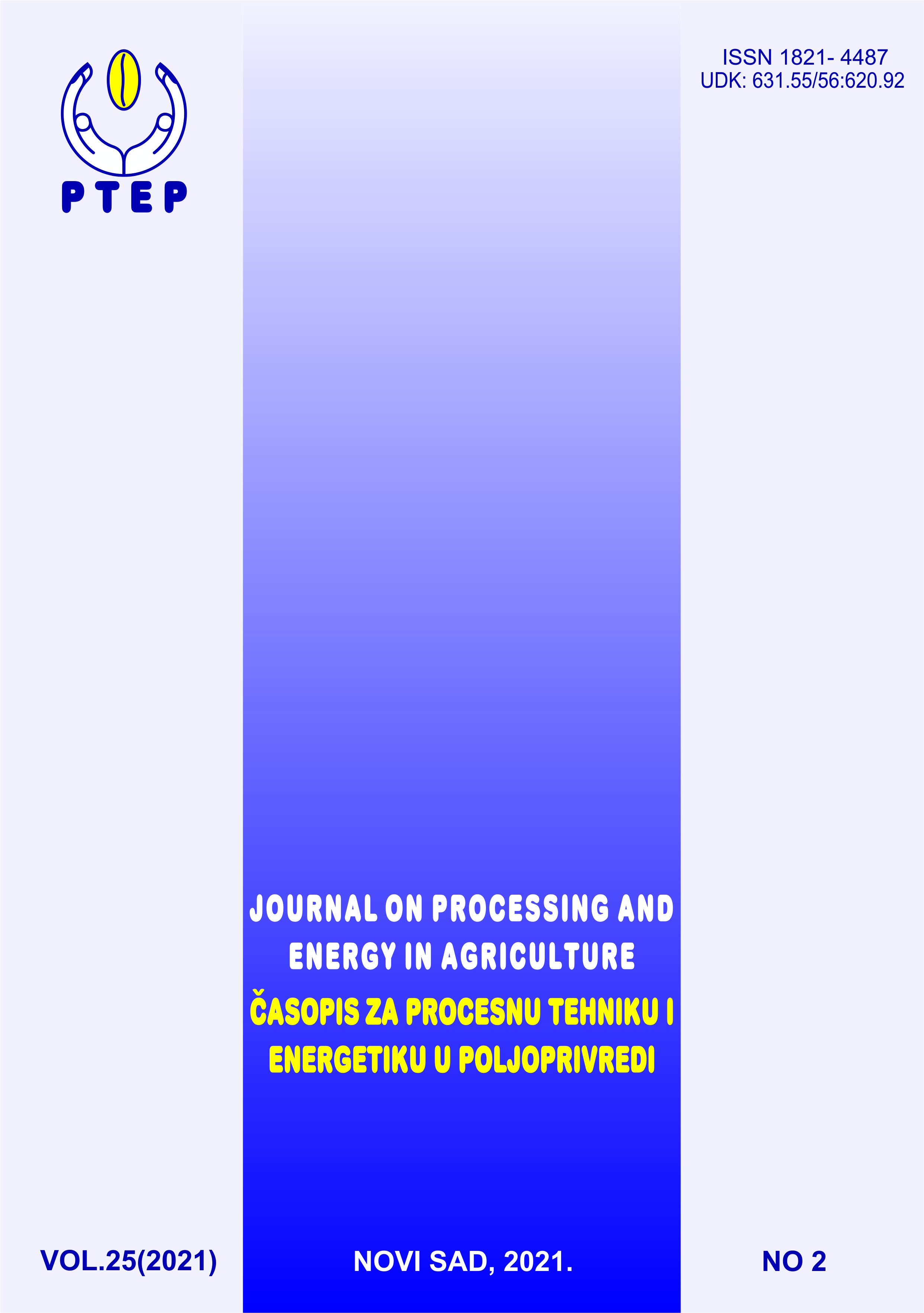STRUKTURA SKROBA U ODNOSU NA FIZIČKE KARAKTERISTIKE ZRNA KUKURUZA
Sažetak
Cilj ovog rada je bio da se ispitaju fizički parametri kvaliteta zrna i struktura skroba različitih genotipova zrna kukuruza koji se gaje u Srbiji. Pored toga, cilj je bio da se utvrdi odnos (korelacija) između ispitivanih karakteristika. Rezultati dobijeni testom tvrdoće po Stenvert-u pokazali su veliku varijabilnost između uzoraka. Udeo frakcije tvrdog endosperma (TE) kretao se u rasponu od 53,29% do 76,28%. Hektolitarska masa (HM) i masa 1000 zrna ili apsolutna masa (AM) 10 različitih genotipova kukuruza kretale su se od 782,69 do 907,39 kgm-3 i od 128,40 do 376,50 g, respektivno. Specifični genotipovi kukuruza imali su najveći sadržaj amiloze (27,8% i 28,9%). Genotip žutog zubana, ZP 606, imao je najmanji sadržaj amiloze u zrnu (22,3%). Rezultati pokazuju da se struktura skrobnih granula razlikuje u zavisnosti od tvrdoće endosperma zrna. Sadržaj amiloze je bio u visokoj korelaciji sa fizičkim parametrima kvaliteta kao što su HM, AM, gustina i TE.
Reference
Alcázar-Alay, S. C., Meireles, M. A. A. (2015). Physicochemical properties, modifications and applications of starches from different botanical sources. Food Science and Technology, 35, 2, 215-236. Epub April 00, 2015.https://doi.org/10.1590/1678-457X.6749
Benedetti, M. P., Sartori, J. R., Carvalho, F. B., Pereira, L. A., Fascina, V. B., Stradiotti, A. C., Pezzato, A. C., Costa, C., Ferreira, J. G. (2011). Corn texture and particle size in broiler diets. Brazilian Journal of Poultry Science, 13, 227-234.
Cornejo-Ramírez, Y. I., Martínez-Cruz, O., Del Toro-Sánchez, C. L., Wong-Corral, F. J., Borboa-Flores, J., Cinco-Moroyoqui, F. J. (2018). The structural characteristics of starches and their functional properties. CyTA - Journal of Food, 16, 1, 1003-1017, DOI: 10.1080/19476337.2018.1518343
Gayral, M., Bakan, B., Dalgalarrondo, M., Elmorjani, K., Delluc, C., Brunet, S., Linossier, L., Morel, M.-H., Marion, D. (2015). Lipid partitioning in maize (Zea mays L.) endosperm highlights relationships among starch lipids, amylose, and vitreousness. Journal of Agricultural and Food Chemistry, 63, 3551-3558.
Ignjatovic-Micic, D., Vancetovic, J., Trbovic, D., Dumanovic, Z., Kostadinovic, M., Bozinovic, S. (2015). Grain nutrient composition of maize (Zea mays l.) drought-tolerant populations. Journal of Agricultural and Food Chemistry, 63, 1251−1260.
International Organization for Standardization (ISO). International Standard: ISO 10520. Determination of starch content – Ewers polarimetric method (1997).
Jane, J., Ao, Z., Duvick, S. A., Wiklund, M., Yoo, S.-H., Wong, K.-S., Gardner, C. (2003). Structures of amylopectin and starch granules: how are they synthesized? Journal of Applied Glycoscience, 50, 167-172.
Kljak, K., Duvnjak, M., Grbeša, D. (2018). Contribution of zein content and starch characteristics to vitreousness of commercial maize hybrids. Journal of Cereal Science, 80, 57-62 doi:10.1016/j.jcs.2018.01.010.
Li, C., Huang, Y., Huang, R., Wu, Y., Wang, W. (2018). The genetic architecture of amylose biosynthesis in maize kernel. Plant Biotechnology Journal, 16, 2, 688-695. https://doi.org/10.1111/pbi.12821
McGrance, S. J., Cornell, H. J., Rix, C. J. (1998). A simple and rapid colorimetric method for the determination of amylose in starch products. Starch, 50, 158-163.
Milašinović-Šeremešić, M., Đuragić, O., Radosavljević, M., Dokić, Lj. (2021). Chapter 2, Maize (Zea mays L.) Suitability for Wet Milling and Animal Nutrition in Relation to Physical and Chemical Quality Parameters. In: Zea mays L.: Cultivation, and Uses, Ed: Dunn, S., Nova Science Publishers, USA. https://novapublishers.com/shop/zea-mays-l-cultivation-and-uses/
Milašinović, M., Radosavljević, M., Dokić, Lj., Jakovljević, J. (2007). Wet milling properties of ZP maize hybrids. Maydica, 52, 289-292.
Milašinović-Šeremešić, M., Radosavljević, M., Srdić, J., Tomičić, Z., Đuragić, O. (2019). Physical traits and nutritional quality of selected Serbian maize genotypes differing in kernel hardness and colour. Food and Feed Research, 46, 1, 51-59.
Pomeranz, Y., Czuchjowska, Z., Martin, C. R., Lai, F. (1985). Determination of corn hardness by Stenvert hardness tester. Cereal Chemistry, 62, 108-110.
Preciado-Ortíza, R. E., Vázquez-Carrillob, M. G., Figueroa-Cárdenasc, J. D., Guzmán-Maldonadoa, S. H., Santiago-Ramosd, D., Topete-Betancourtc, A. (2018). Fatty acids and starch properties of high-oil maize hybrids during nixtamalization and tortilla-making process. Journal of Cereal Science, 83, 171-179.
Radosavljevic, M., Bekric, V., Bozovic, I., Jakovljevic, J. (2000). Physical and chemical properties of variuos corn genotypes as a criterion of technological quality. Genetika, 32, 319-329.
Raigond, P., Dutt, S., Singh, B. (2019). Resistant Starch in Food. In: Mérillon JM., Ramawat K. (eds) Bioactive Molecules in Food. Reference Series in Phytochemistry. Springer, Cham. https://doi.org/10.1007/978-3-319-78030-6_30
Semenčenko, V., Mojović, L., Đukić-Vuković, A., Radosavljević, M., Terzić, D., Milašinović-Šeremešić, M. (2013). Suitability of some selected maize hybrids from Serbia for the production of bioethanol and dried distillers' grains with solubles. Journal of the Science of Food and Agriculture, 93, 811-818.
STATISTICA (Data Analysis Software System) (2018). v.13.3., Stat-Soft, Inc., USA (www.statsoft.com).
Trináctý, J., Nedelník, J., Lang, J., Loučka, R., Kučera, J. (2016). Effect of maize kernel endosperm type and maturity stage on ruminal in situ degradability and post-ruminal in vitro dry matter and starch digestibility. Czech Journal of Animal Science, 61, 351-359.
Van Hung, P. , Maeda, T., Morita, N. (2006). Waxy and high‐amylose wheat starches and flours-characteristics, functionality and application. Trends in Food Science and Technology, 17, 448-456.

